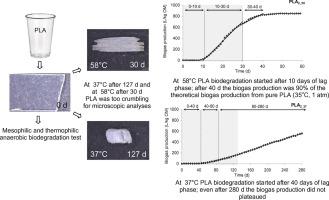Waste Management ( IF 7.1 ) Pub Date : 2020-10-23 , DOI: 10.1016/j.wasman.2020.10.006 Katarzyna Bernat , Dorota Kulikowska , Irena Wojnowska-Baryła , Magdalena Zaborowska , Sylwia Pasieczna-Patkowska

|
Recently, the use of bio-based products, including biodegradable poly(lactic acid) (PLA), has increased, causing their rapid growth in municipal waste streams. The presence of PLA in biowaste may increase biogas production (BP). However, the rate of PLA biodegradation, which affects the time frame of anaerobic digestion, is a key parameter for an efficient process. In this study, detailed kinetics of BP from PLA were determined at 58 °C and 37 °C. At both temperatures, lag phases were observed: 40 days at 37 °C, and 10 days at 58 °C. After the lag phase BP proceeded in two phases, differed in process rate. At 58 °C, during the 1st phase (up to day 30), the rate of BP (rB1,58) equaled about 35 L/(kg OM·d). At the end of this phase, the amount of biogas was 710 L/kg OM, which constituted 84% of the maximal BP (831–849 L/kg OM). In the 2nd phase (10 days), only 13% of maximal BP was produced (rB2,58 of 16.1 L/(kg OM·d)). At 37 °C, maximal BP (obtained after 280 days) was 1.5-fold lower (558–570 L/kg OM) than at 58 °C. In the 1st phase (100 days), rB1,37 was 1.4 L/(kg OM·d); at the end of this phase, BP constituted merely 14% of the maximal BP. A majority of biogas was produced in the 2nd phase (the next 180 days), and rB2,37 doubled to 2.6 L/(kg OM·d)). At 58 °C, intensive biogas production took place when PLA pieces were still visible. At 37 °C, in contrast, biogas was mainly produced when the PLA pieces had been disintegrated. Although PLA anaerobically biodegrades and produces a high yield of biogas, the time frame of PLA digestion is much longer than that of biowaste and, in thermophilic conditions requires separate digesters. In mesophilic conditions, however, is unacceptable at technical scale.
中文翻译:

用PLA基材料生产嗜温和中温沼气:可能性和局限性
近来,包括可生物降解的聚乳酸(PLA)在内的基于生物的产品的使用已经增加,导致其在城市废物流中的快速增长。生物废料中存在PLA可能会增加沼气产量(BP)。但是,影响厌氧消化时间框架的PLA生物降解速率是有效流程的关键参数。在这项研究中,测定了PLA和BP在58°C和37°C下的详细动力学。在两个温度下均观察到滞后阶段:在37°C下40天,在58°C下10天。在滞后阶段之后,BP分两个阶段进行,处理速率有所不同。在58°C下的第一阶段(直到第30天),BP的速率(r B1,58)约等于35 L /(kg OM·d)。在此阶段结束时,沼气量为710 L / kg OM,占最大BP(831–849 L / kg OM)的84%。在第二阶段(10天),仅产生了最大血压的13%(r B2,58为16.1 L /(kg OM·d))。在37°C时,最大BP(280天后获得)比58°C低1.5倍(558-570 L / kg OM)。在第一阶段(100天),r B1,37为1.4 L /(kg OM·d);在此阶段结束时,BP仅占最大BP的14%。在第二阶段(接下来的180天)中产生了大部分沼气,r B2,37翻倍至2.6 L /(kg OM·d))。在58°C时,仍然可以看到PLA碎片,因此产生了大量沼气。相反,在37°C,分解PLA碎片时主要产生沼气。尽管PLA厌氧生物降解并产生高沼气,但是PLA消化的时间框架比生物垃圾要长得多,并且在高温条件下需要单独的消化器。然而,在中温条件下,在技术规模上是不可接受的。











































 京公网安备 11010802027423号
京公网安备 11010802027423号